How Do I Add Another Collar To My Petsafe Wireless
The wireless transmitter creates a circular containment area for your pet. The transmitter is at the centre of the circle.
Choose a location for your transmitter that meets the post-obit criteria:
- 0.5 - i metre above the flooring located on the ground floor of your home.
- Dry out, well ventilated, protected area where temperatures do not drop below freezing.
- At to the lowest degree i metre away from large metal objects.
- About a standard wall outlet.
- You may also cull to place your transmitter on a non-metal table or mount the unit on a wall. Nosotros recommend that yous do not mountain the transmitter until you have confirmed that you are pleased with the containment area the transmitter creates for your pet. This is but in instance y'all need to move or conform the transmitter.

Afterwards you have called the location for your transmitter, next:
- Plug your transmitter into a standard wall outlet.
- Plough the transmitter on.
- Conform the boundary control knob to eight and the boundary switch to loftier.
- Brand sure the receiver neckband battery is properly installed, the static stimulation level is gear up at 2 or greater, and the test low-cal tool contacts are touching the contact points of the collar.
- Hold the receiver collar downwards depression and in front of you and walk out into your garden.
- When you hear the neckband beep and the test light tool illuminates, this represents the boundary of the containment area.
- At this point, you lot may wish to install the purlieus flags included with your system to aid you lot get a visual of the purlieus area. You lot volition need the flags to brainstorm training your canis familiaris equally well.
If yous wish to adjust the boundary surface area, you can either adjust the size of the area past adjusting the purlieus punch upwards or down, or you can arrange the location of the boundary area by moving the transmitter within your abode.
Close
Consider the layout of your garden, its size and the expanse that y'all desire to create for your pet to relish. The wireless fence creates a circular containment surface area, with the transmitter in the centre of the circle. Make certain the unabridged pet surface area lies within your property boundaries. If the boundary zone will be less than 14 metres from the transmitter, place the boundary switch on 'low'. If the boundary zone volition be greater than 14 metres identify the boundary switch on 'loftier'. Remember that you may as well motion the transmitter within your habitation to accommodate the location of the containment expanse as needed.
You can use one of 2 methods to set up and check your boundary area.
Two-Person Method
One person should hold the receiver collar at your pet'due south neck height with logo side facing away from the transmitter. This person with the collar should walk out into the garden to the edge of the desired containment area. Facing away from the transmitter, hold the receiver neckband at the edge of the desired pet expanse. The second person, should exist at the transmitter. Begin with the boundary control dial fix to 8, the person at the transmitter should turn the dial down SLOWLY. When the receiver neckband starts to beeps, tell the person at the transmitter to stop turning the purlieus control dial. Using cell phones to communicate with each other may help to brand this procedure easier. Now your boundary is fix. Note the boundary setting on the transmitter for hereafter reference
Ane-Person Method
Mensurate the shortest distance from the desired boundary zone to the transmitter. Notice the distance on the transmitter range chart below and set the boundary switch and purlieus command dial. Accept the receiver collar to the boundary zone with the receiver collar at your pet's neck acme with logo side facing away from the transmitter. Determine where the receiver collar begins to beep. If the receiver collar beeps earlier or after the desired purlieus zone, return to the transmitter and adapt the boundary command dial. Repeat this process until the receiver collar is beeping at the desired location. Record your settings in your operating guide or next to the transmitter for future reference.
Close
The flags should get only inside of the boundary zone, or forth the wire for in-ground fences. To locate the boundary:
- Remove the receiver collar from your pet and ensure it is on.
- Hold the exam light to the receiver collar contact points and walk into your garden.
- Agree the collar and test light at the level of your pet'south pinnacle.
- Walk towards the warning zone until the receiver collar beeps and the test light tool illuminates. The higher the level of stimulation of the receiver neckband, the brighter the light with wink. If you cannot encounter the light wink, increase the level of stimulation of the collar for the purpose of determining boundary flag location only.
- Place a purlieus flag in the basis at the location where you lot hear the beep and see the lite of the examination light tool wink.
- Walk back into the pet area until the beeping stops.
- Repeat this process around your garden, placing flags every 3 metres until the containment surface area is fully marked with flags.
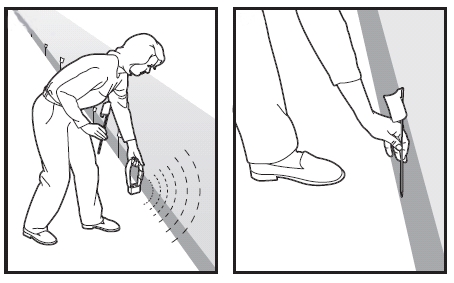
Close
- The proper fit and placement of your receiver collar is important for effective preparation. The contact points must accept direct contact with your pets skin on the underside of their cervix. To ensure a proper fit, please follow these steps:
- Make sure that the battery is not installed in the receiver collar.
- Start with your pet standing comfortably.
- Center the contact points underneath your pet'south cervix, touching the skin. If your pet has a long or thick coat, consider using the long contact points to reach through the fur. These can be purchased by contacting our Customer Care Heart. It is sometimes necessary to trim the hair around the contact points to make certain that contact is consistent.
- Cheque the tightness of the receiver collar by inserting one finger between the end of a contact point and your pet's cervix. The fit should exist snug but not constricting.
- Allow your pet to wear the neckband for several minutes then recheck the fit. Check the fit again as your pet becomes more comfy with the receiver collar.
- Next, trim the neckband length. Mark the desired length of the receiver neckband with a pen. Permit for growth if your pet is young or grows a thick winter coat.
- Remove the receiver collar from your pet and cut off the backlog strap.
- If your receiver has a nylon strap, seal the edge of the cutting neckband past applying a flame forth the frayed edge.
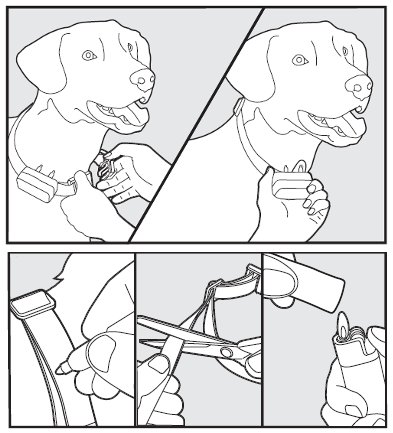
Shut
All pets are different, then it'south important to be patient with yourself and your pet. Some pets may understand the preparation quickly, and others may take more fourth dimension. Paying attention to your pet while you are going through the training and having patience will ensure yous both bask years of liberty and condom.
Goal
The goal of phase 1 training is to familiarise your pet with the boundary flags, boundary, tone and stimulation. You volition introduce your pet to the tone and the static stimulation and teach your pet where it happens.
Setup
- Turn your pet's receiver collar on and set it to level i, the tone only setting. If your neckband does not have a tone only setting, do not place the collar on your pet during this stage of training.
- Place the receiver collar on your pet's neck or simply hold the collar near enough for your pet to hear the beeping of the collar during preparation.
- Put a separate not-metallic collar on your pet's cervix ABOVE the receiver collar and attach a lead. Be sure the extra collar does not put pressure on the contact points.
Familiarising your pet with the boundary flags
- Begin by having some play fourth dimension with you pet, making it fun for your pet.
- Walking your pet on a lead in the pet expanse.
- Movement towards the boundary flags. Allow your pet to hear the warning tone, so pb your pet back into the containment area quickly. Praise your pet when he leaves the purlieus zone.
- Repeat this process at several different purlieus flags.
- Continue the grooming until your pet resists going most the boundary flag. It may assistance to say "no" if your pet attempts to go most the flags.
- Piece of work with your pet in 15 minute increments. Have about iii training sessions per day.
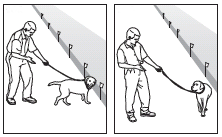
Introducing your pet to the static stimulation
- With the collar on your pet and in the "on" position, walk your pet on a pb in the pet area.
- Calmly praise and talk to your pet.
- Allow your pet to move toward the boundary flags.
- When your pet enters the warning zone, the receiver collar volition activate and offset beeping. Equally your pet continues past the flags into the static stimulation zone, he will receive a static stimulation.
- Immediately subsequently your pet receives a stimulation, pb him back into the pet surface area. Praise him warmly and continue very calm body language.
- Echo this process at several different boundary flags. Never pull or telephone call your pet into the static stimulation zone.
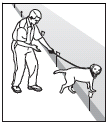
Close
Training sessions should showtime at x-fifteen minutes, gradually increasing to over an hour. Your pet is prepare for this footstep simply when he conspicuously avoids the entire boundary flag line, regardless of any distractions or temptations. During this step, do non leave your pet unattended.
Goal
To railroad train your pet to stay within the pet area even with distractions outside of the pet surface area.
Setup
- Put a separate non-metallic neckband on your pet's neck ABOVE the receiver collar and attach a pb. Be sure the extra collar does non put pressure on the contact points.
- Create distractions to tempt your pet to enter the alarm and static stimulation zones, such equally having a family member cross from within the pet area to outside of information technology, throwing a brawl outside of the pet expanse or having a neighbor walk their pet outside the pet expanse.
Steps
- Put the collar on your pet in the "on" position.
- Walk your pet on a lead toward the boundary flags. Use one of the lark methods listed above. If your pet follows, let him feel a stimulation and chop-chop lead him back into the pet area and praise him. If your pet does non follow the family member, praise him warmly.
- Have a family member or a neighbour with a dog walk outside the pet area parallel to the boundary flag line.
- Repeat the interaction with your pet equally in steps 1 and two.
- With your pet on a lead, throw a ball exterior the boundary flag line. Again, repeat the interaction with your dog as in previous steps.
- Echo distractions at several unlike boundary flags.
Close
Goal
To give your pet free run of the pet area off the atomic number 82.
- Walk around the garden and play with your pet, staying inside the pet surface area at all times.
- Preoccupy yourself with another task in the garden while watching your pet.
- Should your pet escape, take the receiver neckband off or turn the arrangement off at the fence transmitter and lead him or her back into the pet area.
- Your pet is at present ready to use the containment organization. Bank check in on your pet at regular intervals.
- Notation: After y'all are satisfied your pet'south training is consummate, remove every other purlieus flag every 4 days until all flags are removed. Save boundary flags for future use.
Close
Yeah. There is no limit to the number of pets you tin can contain with the containment system. Information technology'southward as elementary equally purchasing an additional (compatible) receiver collar for each pet. You tin can purchase additional receiver collars online or contact our Customer Care Centre.
Before making any changes to your system, remove the receiver collar from your existing pet(southward). When adding pets to new or existing electronic fence systems, cheque the boundary limits for each receiver neckband separately earlier using on your pet and adjust the transmitter range equally necessary.
Close
Yeah, the receiver tin be identify on any non-metal strap. However, you must be able and willing to "punch" two holes in your pet's current collar so that the contact points can be properly inserted. Practise not attach a atomic number 82 to a collar that has a receiver on it. This can cause additional pressure on your pet's neck through the contact points in the collar.
Close
If it is a model with a stimulation level button, press and hold the push downwards for approximately xx seconds. For models without this button, accept the battery out for about 1 minute or take it to the boundary and activate the collar until information technology no longer corrects. Make sure that the tab nether the bombardment is lifted, if applicable.
Close
Never leave the receiver collar on your pet for more than 12 consecutive hours and remove the receiver collar from your pet when indoors for your pet's condolement. Millions of pets are comfortable while they article of clothing stainless steel contacts. Here are some of import steps for the health and condolement of your pet:
- Proper fit of the collar is important. A collar worn for too long or made likewise tight on the pet's neck may cause peel damage. Ranging from redness to pressure ulcers; this condition is commonly known every bit bed sores.
- When possible reposition the collar on the pet's neck every few hours.
- Check the fit to prevent excessive pressure.
- Always follow the instructions in your product operating guide.
- Never connect a lead to the electronic collar; it volition cause excessive pressure level on the contact points within the neckband.
- Wash the domestic dog's neck area and the contacts of the collar weekly with a damp cloth.
- You may demand to trim your pet's pilus in the surface area of the contact points for your arrangement to function properly. Still, never shave the dog's cervix; this may atomic number 82 to a rash or infection.
- Some pets have sensitivity to the contact points in the collar, a status similar to bed sores in humans. You may detect afterward some time that your pet is very tolerant of the collar. If so, you may relax some of these precautions.
If a rash or sore is found on your pet:
- Discontinue use of the collar until the skin has healed.
- If the condition persists beyond 48 hours, see your veterinarian.
Close
Pets should be at to the lowest degree six months sometime before you start preparation them to use a containment system.
Close
This can happen if the static stimulation level is too loftier. Information technology is best to outset on the everyman level of stimulation and increase the levels gradually. To solve your immediate outcome, lower the static stimulation level and reassure your pet and offer praise.
Brand sure yous are in control of the situation when your pet receives his/her get-go static stimulations (take him/her on a lead attached to a divide, non-metallic collar) and lead him into the pet expanse and praise him/her. If your pet remains fearful, suspend training and commencement again the next day. Make sure to stop all preparation sessions on a positive notation with lots of praise and play.
Shut
Plug the transmitter into another wall outlet. If the lights don't come on, contact our Client Care Centre.
Close
- Make sure the receiver is non on level 1.
- Apply the test lite tool to double cheque.
- Make sure the transmitter isn't on beep only (annotation that not all models have this feature).
- Contact our Customer Intendance Middle for additional troubleshooting.
Close
When replacing batteries in your receiver collar, please brand sure you lot insert the batteries while standing within 1.5 – 3 metres of the transmitter. If using a receiver collar with multiple levels of stimulation, press and hold the stimulation level push button until the LED diminishes earlier installing the new battery.
Close
This is used to reprogram the receiver collar to the transmitter in the result of signal loss, for testing purposes to ensure the receiver and transmitter are communicating and in the event that the receiver collar is not responding as it should be. Remove all receiver collars from all pets before proceeding.
- Remove battery from receiver neckband(s). If using a receiver collar with multiple levels of stimulation, press and hold the stimulation level button until the LED diminishes. This discharges any battery energy that may have remained in the receiver collar. Besides, elevator the metal tab that has a crash-land on the end that is located in the centre of the battery compartment.
- Put boundary switch on transmitter in the 'high' position.
- Turn the purlieus control dial on the transmitter to position four.
- Standing within 1.5 - 3 metres of the transmitter, re-insert the batteries into the receiver neckband(southward).
- Test the boundary past walking out into the safe zone until your receiver responds.
If your receiver collar(due south) does not reply, echo steps i - 5. To become the normal boundary settings, punch the boundary command dial toward viii until the desired purlieus settings are established.
Shut
Drain the battery. Effort new batteries if that fails. Replace the receiver if both steps fail.
Shut
- Trees and shrubs will not affect the arrangement.
- Do not place the transmitter in or near fixed large metal objects such as metal sheds and cars. Large metal objects can affect the signal by reducing the maximum range of the arrangement at the location of the object. As a result, your pet may receive a static stimulation. If you accept a great deal of metal in your garden that you feel my impact your arrangement, y'all may want to consider an in-ground wired containment system for you and your pet instead.
- The system volition work on a mildly sloped garden. The transmitter bespeak extends 27-32 M depending on the model (old or new)in all directions. A sloping garden or one with hills tin crusade the pet area to appear less or more than expected. Consider repositioning the transmitter to maximise your pet expanse.
- Wireless routers can cause inconsistency in betoken or reduced range. To examination if a wireless router is causing bug, plow the router off, and see if the problem persists. It may be helpful to move the transmitter closer to the router to avert issues. Endeavour putting the transmitter close (well-nigh thirty-50cm) to router. At that place will exist a place where both signals will not interfere with each other.
Shut
- In-ground system: creates a perimeter of whatsoever shape and can take exclusion areas inside information technology. The wire is usually buried just nether the ground and can fifty-fifty run through streams. You can also purchase additional wire that volition create a perimeter of upward to g ares (25 acres) (selected systems just).
- Wireless arrangement: creates a circular perimeter around a key transmitter with a bore of up to 64 meters (selected systems only) It is a portable system, but the dog should ever be fully trained and familiar with the surface area in which the system is used.
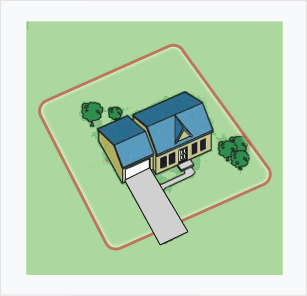
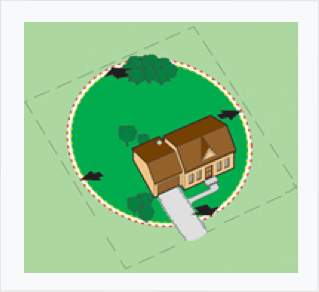
In add-on, there are systems that use receiver collars which are specifically designed for minor dogs, cats and stubborn dogs. Buy an extra compatible receiver neckband for each boosted pet who will use the system. Note that certain systems are not compatible and in-ground and wireless collars are not compatible.
Close
The static stimulation is safe and harmless. It is effective enough to become your pet's attending.
Close
No. Containment systems are only effective on pets who wear the receiver neckband. Other animals can however enter your garden.
Shut
Many of our collars and systems are compatible. Check your system for a list of compatible collars below.
Note that wireless collars and transmitters aren't compatible with in-ground systems and collars. Yous tin't add a wireless collar to an existing in-ground arrangement, for example.
| These fence systems | Piece of work with these receivers | ||
|---|---|---|---|
Wireless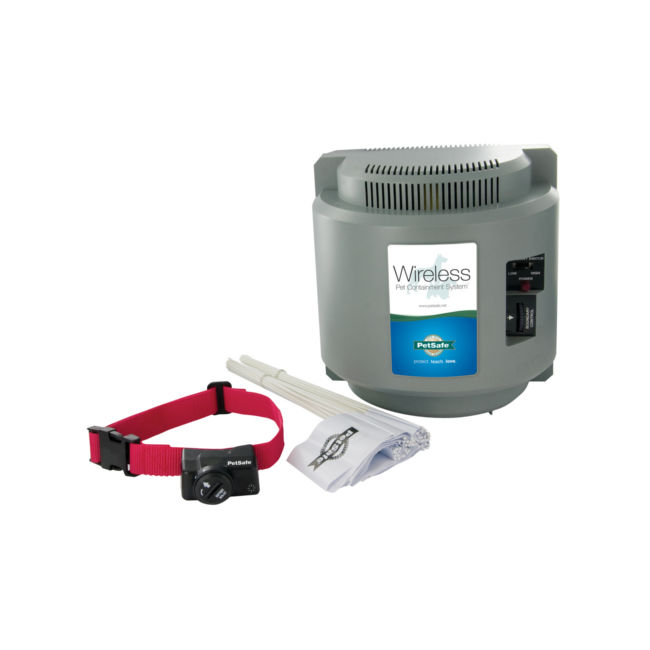 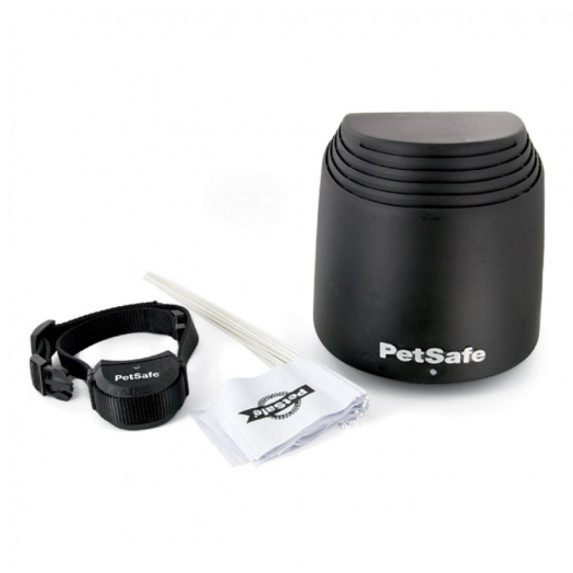 | Wireless Pet Containment™ Arrangement Stay+Play Wireless Debate™ | Wireless Pet Containment™ Organization Add together-A-Domestic dog® Actress Receiver Collar Stay+Play Wireless Fence™ Add-A-Domestic dog® Actress Receiver Neckband Stay+Play Wireless Fence™ Stubborn Dog Add-A-Dog® Extra Receiver Neckband | |
| These fence systems | Work with these receivers | ||
In-Ground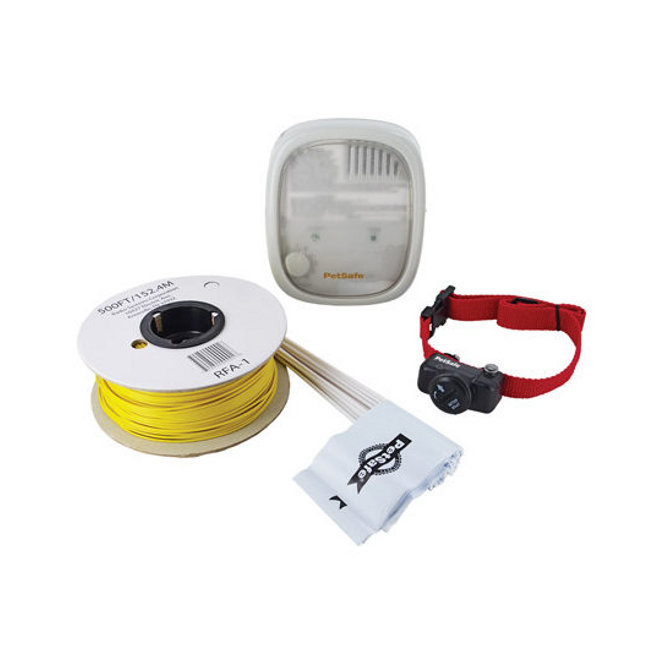 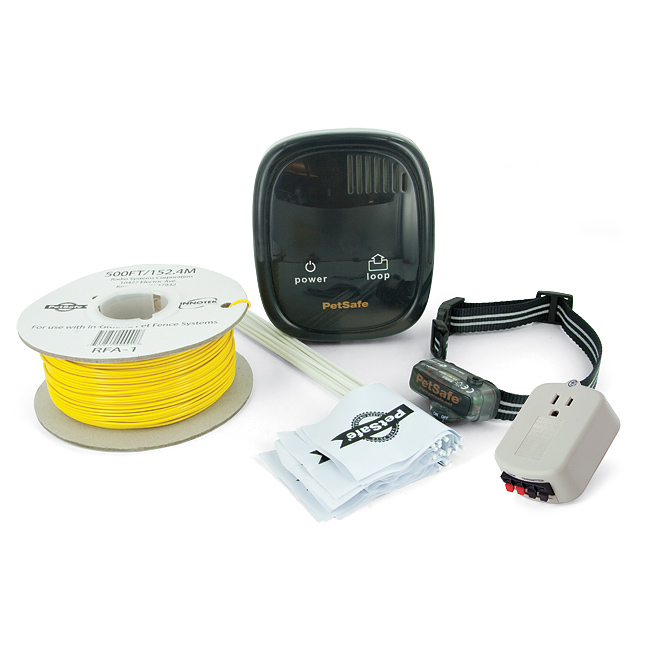 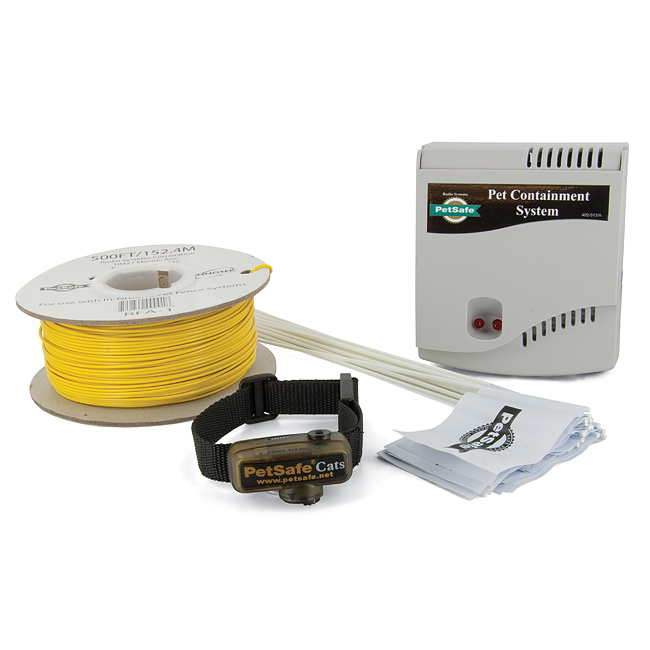 | In-Ground Debate™ System Stubborn Canis familiaris In-Ground Debate™ Arrangement Piddling Dog Deluxe In-Footing Debate™ Organisation Innotek® Rechargeable In-Ground Pet Contend™ System Deluxe In-Ground Cat Debate™ System | Ultralight™ Add-A-Dog® Actress Receiver Collar Stubborn Dog Add-A-Dog® Actress Receiver Collar Picayune Domestic dog Add-A-Dog® Extra Receiver Collar Innotek® Rechargeable Extra Receiver Collar Deluxe In-Ground Cat Fence™ Extra Receiver Collar | |
Close
How Do I Add Another Collar To My Petsafe Wireless,
Source: https://intl.petsafe.net/en-gb/support/wireless-containment-system-add-a-dog-extra-receiver-collar#:~:text=Place%20the%20receiver%20collar%20on,pressure%20on%20the%20contact%20points.
Posted by: lynnantither.blogspot.com


0 Response to "How Do I Add Another Collar To My Petsafe Wireless"
Post a Comment